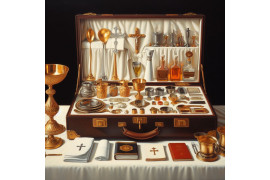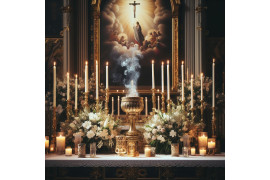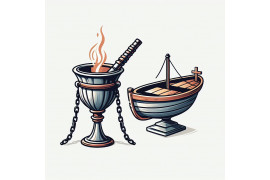Holy water sprinklers have a rich history that spans across different cultures and religions. Dating back to ancient times, these sacred objects hold significant symbolism and are used in various religious ceremonies and rituals. The design and materials of holy water sprinklers have evolved, but their purpose remains the same - to distribute holy water for blessings and purification.
Traditionally crafted from wood, metal, or glass, holy water sprinklers are carefully designed to disperse the blessed water in a controlled manner. Each culture and religion may have its own unique variation of the holy water sprinkler, reflecting their beliefs and practices.
Join us as we dive into the captivating world of these sacred objects.
Purpose and Symbolism of Holy Water Sprinklers in Religious Ceremonies
Holy water sprinklers are an essential part of religious ceremonies, serving the purpose of blessing people, objects, or spaces. These sprinklers hold great symbolism and signify purification, protection, and the presence of divine grace.
The act of sprinkling holy water is believed to have the power to ward off evil spirits and bring spiritual cleansing. It is seen as a way to invoke God's blessings and sanctify individuals or objects involved in religious rituals. The use of holy water sprinklers dates back centuries and holds deep significance in various faith traditions.
Blessing People, Objects, or Spaces
During religious ceremonies, priests or clergy members use holy water sprinklers to bless individuals by lightly spraying them with holy water. This act symbolizes the purification of the soul and protection from evil forces. By receiving this blessing, believers seek spiritual guidance and strength for their journey.
Holy water sprinklers are also used to bless objects such as rosaries, crucifixes, or medals. This ritual imbues these items with sacredness and serves as a reminder of one's faith. Spaces like churches or homes can be blessed using holy water sprinklers to create a sacred environment where believers can seek solace and find peace.
Symbolizing Purification
The act of sprinkling holy water represents purification both physically and spiritually. Water has long been associated with cleansing rituals across cultures. In religious contexts, it is believed that holy water has been consecrated through prayers and blessings by clergy members.
By using a holy water sprinkler during religious ceremonies, individuals participate in a symbolic act of washing away sins or impurities. This purification process allows believers to start anew with a cleansed spirit and renewed devotion to their faith.
Warding Off Evil Spirits
One significant belief surrounding the use of holy water sprinklers is their ability to ward off evil spirits. It is believed that the presence of holy water acts as a deterrent to negative energies and malevolent forces. By sprinkling holy water, believers seek protection from harm and invite divine intervention into their lives.
The act of sprinkling holy water during religious ceremonies also serves as a reminder of God's presence and His ability to protect His followers from spiritual dangers. It reinforces the belief in the power of faith and the role it plays in safeguarding individuals from evil influences.
Role in Sacraments
Holy water sprinklers play a vital role in various sacraments within different religious traditions. For example, in the Christian tradition, baptism involves the use of holy water sprinklers to symbolize purification and initiation into the faith community. The sprinkling of holy water on an individual's forehead represents their rebirth as a follower of Christ.
Similarly, other sacraments like weddings or funerals may incorporate the use of holy water sprinklers to invoke blessings upon those involved. These rituals serve as important milestones in an individual's spiritual journey and are marked by the symbolic act of using holy water.
The Parker Holy Water Sprinkler: Unveiling its Connection to Aspersorium and Sprinkler Pots
The Parker Holy Water Sprinkler, invented by John W. Parker in the 19th century, is a unique type of holy water dispenser that combines features of both aspersorium (holy water containers) and traditional sprinkler pots. This innovative design allows for controlled dispensing of holy water, making it a practical and convenient tool for religious ceremonies.
Combining the Features
The Parker Holy Water Sprinkler was created intending to providing an all-in-one solution for sprinkling holy water during religious rituals. By incorporating elements from both aspersorium and sprinkler pots, this device offers a versatile approach to dispensing holy water.
Controlled Dispensing
One of the key advantages of the Parker Holy Water Sprinkler is its ability to control the amount of holy water being dispensed. Unlike traditional methods where an aspergillum or hyssop is used to sprinkle water manually, this sprinkler provides a more precise and uniform distribution.
Practicality and Ease of Use
The popularity of the Parker Holy Water Sprinkler grew rapidly due to its practicality and ease of use. Its design allows for easy handling, making it suitable for various religious settings such as churches, temples, or even outdoor gatherings like camps or congregational events.
Versatility in Ceremonies
This versatile tool can be used in a wide range of religious ceremonies. Whether it's during baptisms, blessings, or other sacred rituals, the Parker Holy Water Sprinkler offers flexibility in its application. It has become an essential item for pastors and clergy members who perform these ceremonies regularly.
A Blend of Tradition and Innovation
The invention of the Parker Holy Water Sprinkler represents a blend of tradition and innovation within religious practices. While maintaining the symbolic significance associated with holy water, this sprinkler introduces a modern approach to its dispensation. It bridges the gap between ancient rituals and contemporary convenience.
A Gift of Blessings
The Parker Holy Water Sprinkler also holds value as a symbolic gift. It can be presented to individuals or families during special occasions such as house blessings or when someone is moving into a new place. By gifting this sprinkler, one bestows blessings and good wishes upon the recipient's home.
Kojima's Pens and the Demonstrator Pen Club
Kojima's Pens, a well-known brand in the writing instrument industry, has been producing top-quality pens since the early 20th century. Their craftsmanship and unique designs have made them popular among pen enthusiasts worldwide. But what sets Kojima's Pens apart is their exclusive community called the Demonstrator Pen Club, dedicated to showcasing a particular type of pen known as "demonstrators."
Transparent pens that reveal their inner workings
Demonstrators are special pens that allow users to see the inner mechanisms while writing or drawing. Unlike traditional opaque pens, these transparent demonstrators offer a unique experience by providing a glimpse into how the ink flows and interacts with various components within the pen.
Craftsmanship meets innovation
Kojima's Pens takes pride in creating demonstrators that combine exquisite craftsmanship with innovative design elements. The transparency of these pens not only adds aesthetic appeal but also serves as a practical feature for those interested in understanding how pens work on a deeper level.
A vibrant community for pen enthusiasts
The Demonstrator Pen Club is an exclusive community where pen enthusiasts can come together to share their love for Kojima's demonstrator pens. Members can connect with like-minded individuals, exchange tips and tricks, discuss new models, and showcase their own collections.
Appreciating the artistry of Kojima's Pens
Being part of this club allows members to appreciate the artistry behind each pen. From intricate engravings to carefully selected materials such as cedar wood for barrel construction, every detail is meticulously crafted to create a truly exceptional writing instrument.
Beyond just functionality
While Kojima's Pens are renowned for their functionality as high-quality writing instruments, they go beyond mere functionality. These pens become symbols of personal expression and style for many users who appreciate both form and function in their everyday lives.
An insignia of status and taste
Owning a Kojima's demonstrator pen is not just about having a writing tool; it's also a statement of status and taste. These pens have become coveted items among collectors and enthusiasts alike, with certain limited-edition models fetching high prices in the market.
Joining the Demonstrator Pen Club
Membership to the Demonstrator Pen Club is by invitation only, reflecting the exclusivity and prestige associated with Kojima's Pens. To join, interested individuals can reach out to the club via email or through their website. Once accepted, members gain access to a community of passionate pen lovers who appreciate the artistry and craftsmanship behind each Kojima's demonstrator pen.
Holy Water Sprinklers in the Medieval Period and Related References
During the medieval period, holy water sprinklers played a significant role in Christian religious practices. These sprinklers were used in various ceremonies and rituals, both in public and private settings. Artworks from that era, such as paintings and sculptures, often depicted the use of holy water sprinklers in religious scenes.
Historical texts and manuscripts provide valuable references to the importance of holy water sprinklers during this time. They highlight the significance of holy water as a symbol of purification and divine blessing. The act of sprinkling holy water was seen as a way to cleanse oneself spiritually and seek protection from evil forces.
The use of holy water sprinklers was closely associated with baptism, one of the sacraments in the Roman Catholic Church. Baptism is considered an initiation into the Christian faith, where individuals are cleansed of their sins and become members of the church community. During baptismal ceremonies, priests would sprinkle holy water on infants or immerse adults in blessed water using a sprinkler.
Holy water sprinklers were also used during other religious rites and sacraments. For example, they were employed during blessings performed by priests or even by popes themselves. The Easter season, which commemorates the resurrection of Christ, saw an increased use of holy water sprinklers in churches worldwide.
These sprinklers were designed to resemble maces or scepters, adding a touch of grandeur to religious ceremonies. They were often made from precious metals like silver or gold and adorned with intricate engravings or gemstones. The elaborate craftsmanship reflected the reverence placed on these sacred objects.
The term "holy" refers to something that is consecrated or set apart for religious purposes. In Christianity, water is considered a living symbol that represents purity and life-giving properties. Holy water is believed to possess spiritual power due to its association with God's grace.
Tracing the Pre-Christian History of Holy Water and its Relation to the Parker Holy Water Sprinkler
The practice of using holy water has a long history that predates Christianity. Ancient civilizations incorporated the use of water in their spiritual rituals, believing it had purifying and protective qualities. This tradition of using sacred water can be traced back to ancient Egypt, where priests would perform ritual cleansings with consecrated water.
The Parker Holy Water Sprinkler draws inspiration from these pre-Christian traditions while adapting them for modern use. The sprinkler is designed to dispense holy water during religious ceremonies, symbolizing purification and blessing. Its purpose is to sprinkle or spray the holy water onto congregants or objects as a form of spiritual cleansing.
By studying historical sources, we can trace the evolution of holy water practices that influenced the design of the Parker Holy Water Sprinkler. One such influence comes from ancient Rome, where lustral basins were used for ritual washings. These basins contained holy water that was sprinkled on participants during religious rites.
Another significant influence on the development of holy water practices is found in early Christianity. Baptismal fonts were used for immersions and ablutions, representing a symbolic washing away of sins and rebirth into the Christian faith. The use of holy water became an integral part of baptismal rituals, signifying spiritual purification.
Understanding these connections provides insights into how ancient beliefs continue to shape contemporary religious practices. The adoption of pre-Christian traditions by early Christians demonstrates a synthesis between old and new beliefs. It also highlights the importance placed on ritual purity and spiritual cleansing throughout history.
The Parker Holy Water Sprinkler serves as a tangible link to this rich history, bridging ancient customs with present-day worship practices. Its design pays homage to centuries-old traditions while offering a practical means for dispensing holy water in modern church settings.
Insights on the Origins and Significance of the Term "Holy Water Sprinkler"
We uncovered connections between the Parker Holy Water Sprinkler and its predecessors, such as aspersoriums and sprinkler pots. We delved into the medieval period to discover references to holy water sprinklers and traced the pre-Christian history of holy water.
By understanding the origins of the term "holy water sprinkler" and its importance in various religious practices throughout history, we gain a deeper appreciation for this ceremonial tool. The insights provided shed light on how these objects have evolved over time and their continued relevance today.
If you are intrigued by religious artifacts or fascinated by cultural traditions, further exploration into the world of holy water sprinklers can be an enriching experience. Consider visiting museums or exhibitions that feature religious artifacts to witness these items firsthand. Engaging with scholars or experts in religious studies can also provide valuable insights into this subject matter.
FAQs
What materials were commonly used to make holy water sprinklers?
Historically, holy water sprinklers were crafted from a variety of materials, including brass, silver, gold, or even precious stones. These materials were chosen for their durability and aesthetic appeal. Today, modern replicas may also be made from more affordable materials like stainless steel or plastic.
How is holy water typically blessed before it is used with a sprinkler?
The process of blessing holy water varies across different religious traditions, but generally involves prayers recited by clergy members invoking divine blessings upon the water. This blessing imbues the water with spiritual significance and sanctity.
Are there any specific rituals associated with using a holy water sprinkler?
Yes, there are often specific rituals associated with using a holy water sprinkler during religious ceremonies. These rituals may include making certain gestures while holding the sprinkler, reciting prayers or invocations, and moving the sprinkler in a particular pattern or direction to distribute the holy water.
Can individuals use holy water sprinklers outside religious ceremonies?
While holy water sprinklers are primarily used within religious contexts, some individuals may choose to have a personal holy water sprinkler for private devotional practices. However, it is important to respect the cultural and religious significance associated with these objects when using them outside their intended purpose.
Are there different types of holy water sprinklers?
Yes, there are various types of holy water sprinklers that have been used throughout history. Some examples include handheld sprinklers with long handles, aspersoriums designed for specific liturgical purposes, and more ornate ceremonial sprinklers used in elaborate religious rituals. The design and style of these sprinklers often reflect the artistic traditions and cultural influences of their respective time periods.



